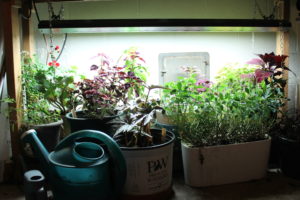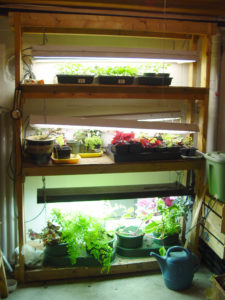What Basement Lights Can Do
March 7th, 2017
Don’t overlook the lowly fluorescent shop light as a way to hold down your plant budget.
This cheapo lighting is good enough not only to start seedlings but to grow cuttings, overwinter tropicals and specimen annuals, and to get a jump on tender bulbs – all in the basement no less.
Not many people take advantage of this… or know it’s possible.
Local gardener/reader Jeff Kosakowski was reading an article on how I start seeds every winter in my unheated basement and got to wondering if that idea also would work for his tender plants.
Jeff emailed me that up to now, he’s been making a seed-starting mess in his den while storing his tender plants in sleep mode in the basement over winter.
“Every year, I haul them down to the basement, then bring them out around frost-free time and let them grow on the deck,” Jeff says. “I would love to get a head start. Also, I order a bunch of bare-root plants each year and would like to give them a head start in the same way, if you think it will work.”
I’m sure both will work because I’ve done it.
A dark, cold basement seems like the last place a plant would be happy, but it actually offers a few benefits.
One is that most non-plant-geek spouses will be a lot happier with the potting mix and watering cans in the basement instead of the living room or den.
Second is that seedlings and overwintering plants do better in the cool, 50-ish-degree temperatures of an unheated basement… better than the warmer, drier confines of the living quarters.
The cool temperature holds down the growth rate and keeps it more in balance with the artificial light you’re giving them from your fluorescent lights.
Upstairs, it might seem warmer and brighter, but winter light is low enough and indoor temperatures high enough that plant growth is often faster than the light can support. That’s why you’ll see room-temperature tomato seedlings usually getting long and “leggy.”
Fluorescent lights are good enough for seedlings and winter growth because you can hang them from chains and keep them suspended just inches from the plants. Since they give out very little heat, they won’t burn or blanch tender leaves like incandescent bulbs can do.
The down side of ordinary, old-fashioned fluorescent tubes is that they’re not terribly potent and don’t give off the full spectrum of light that the sun does.
You’re not likely to get much (if any) flowering or fruiting out of plants growing under fluorescent lights. For serious growing or indoor bloom, plant geeks usually turn to so-called “grow lights,” which are generally one of two types of high-intensity discharge lights: metal halide or high-pressure sodium.
These days, you’ll also run into the option of higher-performing T5 fluorescent lights, which are brighter than, more efficient than, and equipped with a better light-spectrum profile than the basic tubes from the home center. (They’re also more expensive, as you might have guessed.)
But if the point is to just get seedlings growing for a few weeks, to keep something alive over winter and not necessarily thriving, and/or to get a head start on spring, the cheapie fluorescents are fine.
I built my own three-tiered unit years ago out of scrap 2-by-4s and plywood. I hang two sets of fluorescent fixtures over each of the three layers, and cut the plywood so that I can fit four flats on each layer.
My main goal was starting seeds of many of the flowers and vegetables that go into my gardens each spring, which is a whole lot less expensive than buying transplants. It also lets me get my fingers into the soil as early as late January each year.
But I soon found that the lights also were good enough to pot up and keep alive some of my favorite annuals and tropicals. I began bringing in one “mother” plant to keep alive until late winter, when I take cuttings that go into the flats along with the seed-started babies.
Plants such as coleus, begonias, Persian shield, alternanthera, wandering jew, geraniums, and plectranthus are some of the easiest to get going. I also always overwinter a few white euphorbias and a Rex begonia vine.
Lately, my wife has been getting into the act by overwintering all sorts of tropicals and houseplants that we use in pots and in the ground outside in summer. It saves a ton of money not having to buy new plants every year.
As reader Jeff is thinking, it’s also easy to get a head start on spring by “forcing” dormant plants into waking up early inside.
You could do this with dormant, borderline-hardy perennials you don’t want to risk losing over winter outside, with mail-order bare-root woody plants, or with summer bulbs/corms/tubers, such as dahlias, cannas, callas, agapanthus and gladioli.
The plants don’t know the difference. So long as they have moist soil, enough warmth to encourage sprouting, and sufficient light to nourish the emerging leaves, they’ll be fine.
Fine for a few weeks, that is. You can’t leave these early starts inside for too long. Even with the cool basement temperatures, they’ll start stretching into legginess if they don’t get some better light soon.
The idea is to do your head-starting about 3 or 4 weeks in advance.
Also important is to give your basement-grown plants 7 to 10 days of gradually getting used to the outside before planting them or leaving them outside in pots round the clock.
Start with a few hours outside in a protected, shaded area, then increase the light and exposure each day over at least 7 days. This is called “hardening-off.”
If you take a basement plant outside and plant it suddenly, it’s a shock that usually wilts the plant and may even kill it. So go easy.
And watch the frost. You don’t want to force a plant, harden it off, then have it die on a frosty night. Remember, tender plants can’t take freezes, so don’t plant them out until danger of frost is gone, which in the Harrisburg area is May 11.
On average, our last frost is around the third week of April, but May 11 is the official, all-time-latest killing frost date for Harrisburg. In outlying areas and in the mountains north of Harrisburg, frost has happened into Memorial Day.









